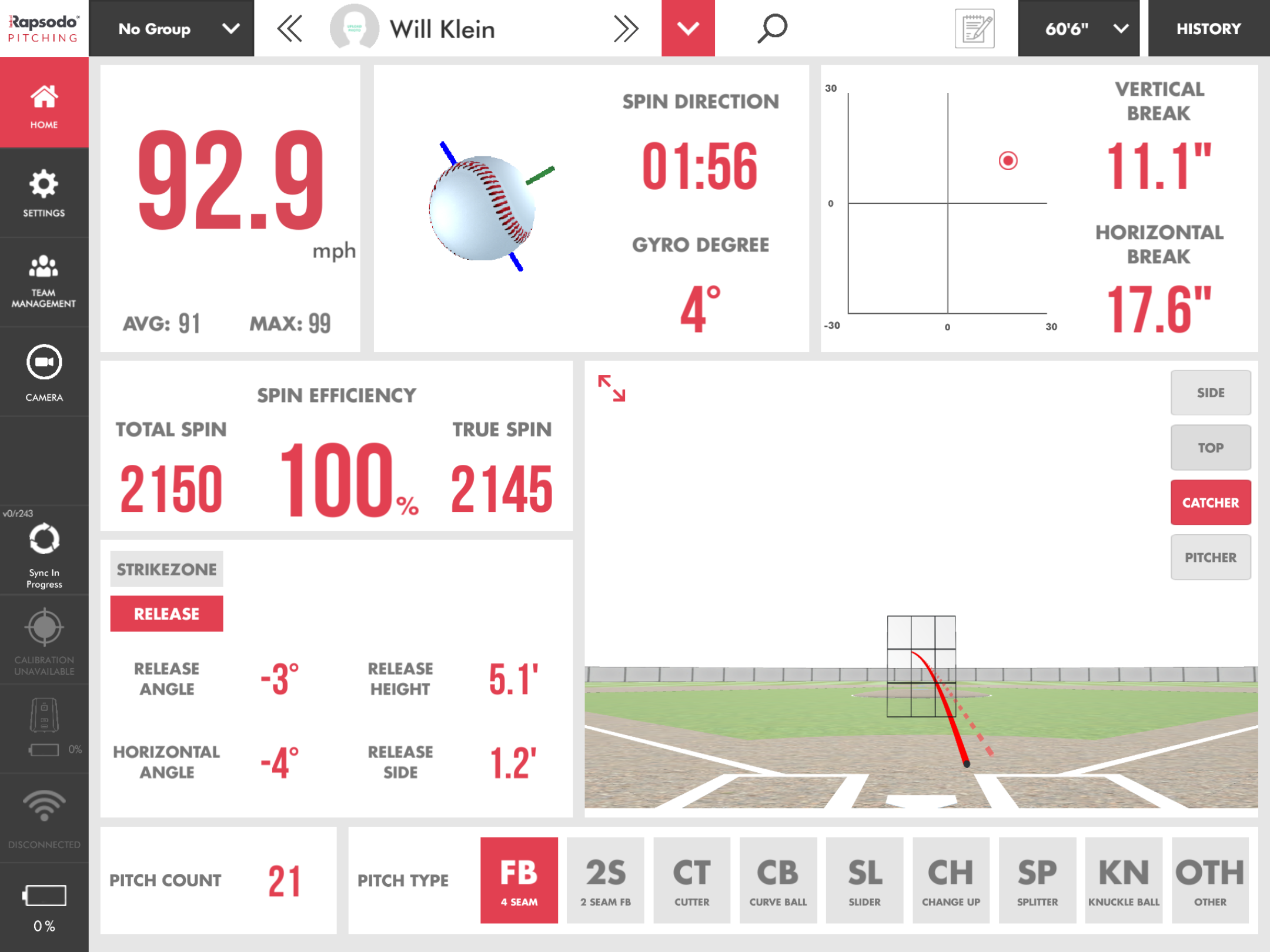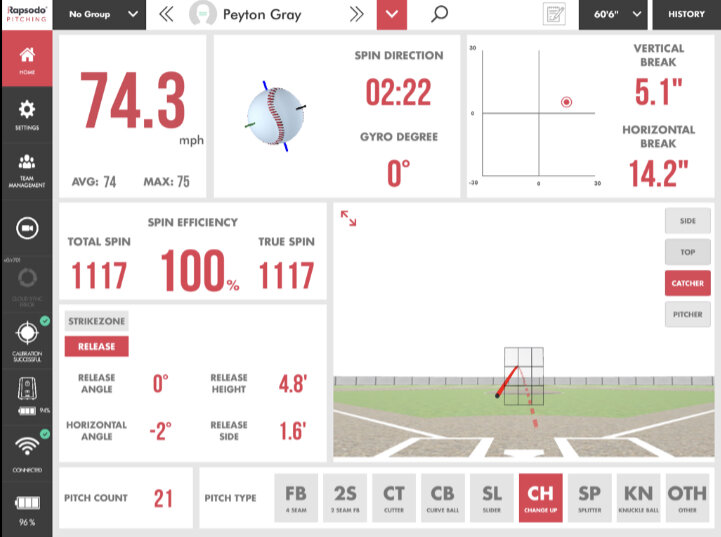Developing A Change-Up
Learn How To Develop The Change-up Using Trackman And Rapsodo:
Below you will see some key aspects on change-up pitch design, assessing spin metrics, and how to develop it.
Designing Your Change-Up
The change-up is a crucial pitch in the arsenal of pitchers at all levels. Players should learn grips and practice it at an early age to improve feel and trust with it as they develop. It is often underused and misunderstood by amatuer pitchers. It will continue to develop the more you use and practice.
Change-ups are lethal due to their difference in velocity but similar appearance of spin/release. The best change-ups maximize movement along with speed differential and slot/release similarities.
A quality change-up is a great tool to have in your arsenal to get hitters off hunting your fastball. When used correctly, the change-up will impact hitters timing to improve your fastball success as well.
It can be misunderstood that change-ups should be slowed down intentionally to create deception. The goal is to be consistent with arm speed, slot, and finish.
Let the grip and spin direction create the movement, not changes in your delivery!
Spin Rate:
Spin rate for a change-up varies based on grip, spin orientation, and slot.
The goal is to create less vertical break and more horizontal break with the change-up. This can be achieved in several ways but more spin does not mean better movement.
Most change-ups have about 500-800 less true spin (rpms) than the player’s fastball. While this varies, lowering the true spin will ultimately create less vertical break due to less spin induced movement. For example, if a pitcher has about 2200 true spin on his fastball then getting to around 1500-1700 is a good start to killing vertical break.
A change-up can have a similar spin profile to the fastball but you will want to see the axis be tilted to the arm side to kill vertical break and add horizontal break.
We will discuss more about the spin direction/axis below, but the spin rate is going to vary between pitchers and is not as important as the axis it spins on.
Spin Axis:
The best way to create less vertical but more horizontal movement profile on the change-up is by tilting the direction/axis it spins on. Notice the difference between these two images at “spin direction”.
The fastball has a 00:20 axis (almost directly over-top) while the change-up is tilted over two hours. This creates a huge differential between 4-seam and change-up movement profiles. The 4-seam has 20.2V/3.6V and change-up has 5.1V/14.2H. While have above 90% spin efficiency, one creates almost no vertical break due to coming out of a much more tilted axis. You can also see that the release angle, release height, horizontal angle, and release side numbers are almost exact same. This shows they should tunnel well out of his hand.
While this is a drastic example of a professional pitcher who specializes with the change-up, it gives a good presentation of what the differences between FB/CH should show.
When looking for valuable data on change-ups with Rapsodo, begin with the movement profile and spin axis.
Spin Efficiency:
The goal is still to create a high spin efficiency on the change-up. There are times that change-ups can have lower spin efficiencies and be successful because of their ability to kill vertical break. Lower efficiency means less true spin which creates less vertical break. However, this hurts the amount of horizontal break (run) it would create. If we can keep the efficiency high and tilt the axis, then the horizontal break will be high.
Most high-level change-ups will have about 95% spin efficiency.
Spin Metrics
As mentioned above, overall metrics will vary from all different types of pitchers and levels. The important data comes from the metrics shown in differences of spin axis, vertical and horizontal break profiles. Messing with different grips, seam orientations, and cueing the finish in different ways can improve metrics.
Shown above -- This Change Up has about 8 inches more horizontal and 8 inches less vertical break from the fastbal due to a tilted axis (from 1:00 FB to 1:54 on CH), less spin rate, high efficiency and more release side.
Coaching the Change-Up:
Grips will vary between ages, arm slots, hand sizes, and more. The circle change is most commonly used, but can also be used in different ways. We recommend starting with these grips below and seeing which ones feel comfortable.
A common cue is “throwing the inner half” or “throw the thumb down” at the finish can but every pitcher receives those cues differently. Personally, I encourage players to emphasize maintaining fastball arm speed and throwing through the middle finger. Another cue we use is to “keep the palm inside the fingers”. This can help create a more angled spin direction.
Pressure on middle finger and thumb is a good place to start with those learning the change-up.
High-speed video and review can really advance the process on what is happening compared to what the pitcher feels happening. You can also use an iPhone slow motion zoomed in to release point.
Achieving more horizontal break than vertical break consistently with the change-up is a good goal to have when assessing movement with Rapsodo and Trackman. The main ways this can be achieved are:
Tilt the axis to arm side
Kill spin rate
Less release height, more release side (may lose tunnelling).
As previously stated, look for 5-8 inches less vertical than your fastball and 5-8 inches more horizontal than your fastball. Every pitcher will be different in achieving this due to arm slot, fastball spin axis, and overall spin rates.
Training the Change-Up:
Throw it! Use it daily in your catch play. We recommend 10-25 change-ups on all hybrid or higher intent throw days regardless of bullpen.
You can get these reps in after you’ve extended your catch play to distance. At about 150-120 feet for HS/College aged arms, do shuffle step throws with your change-up on a line. Add 2-3 throws every 15-20ft on the the way back in. Younger athletes can do this at 75-60 feet.
If working on the spin, throw it into a net about 50-60 feet away to see the angle and movement on it. The more you work on maintaining arm speed and throwing it downhill, the better!
For more information email us at gvogt@prpbaseball.com!





